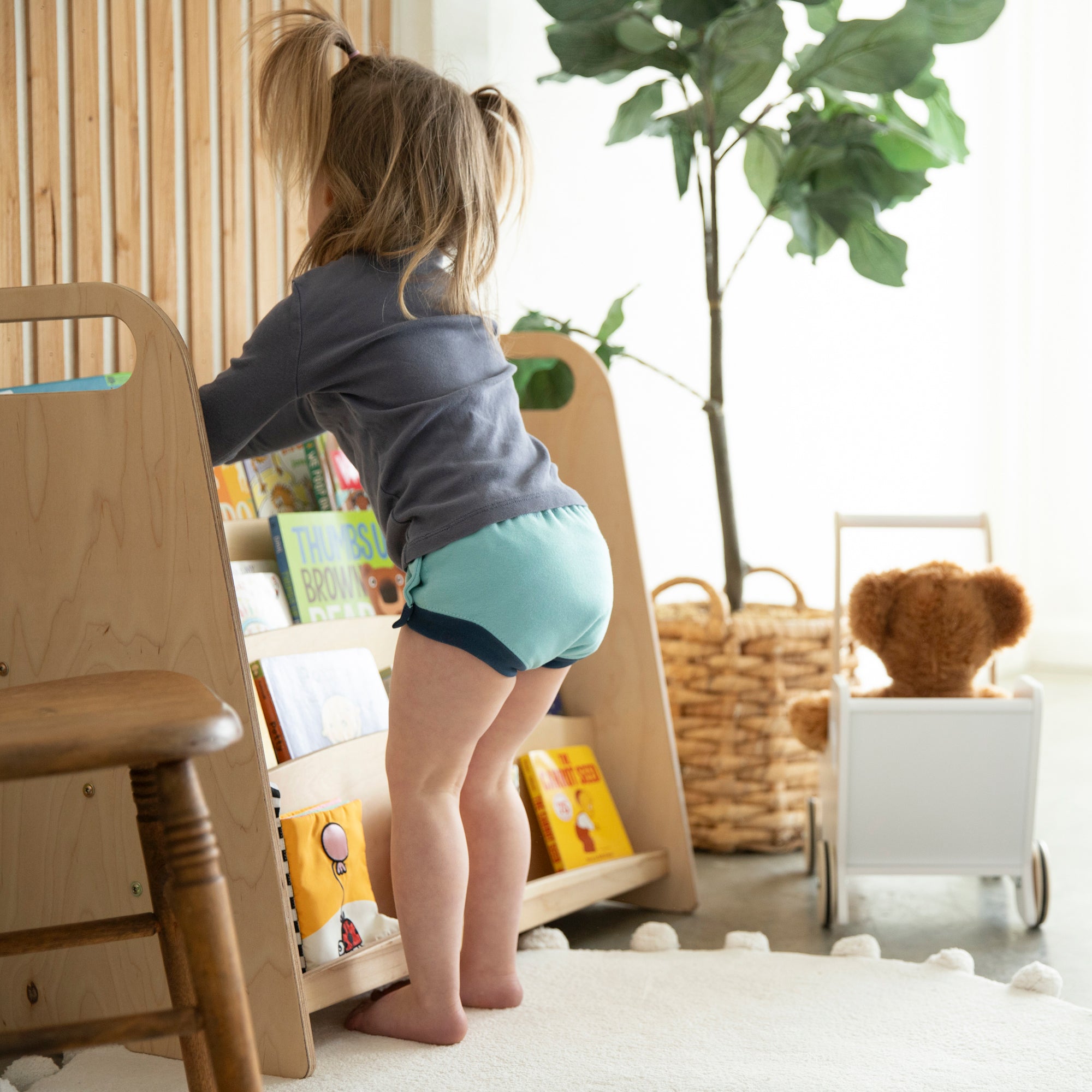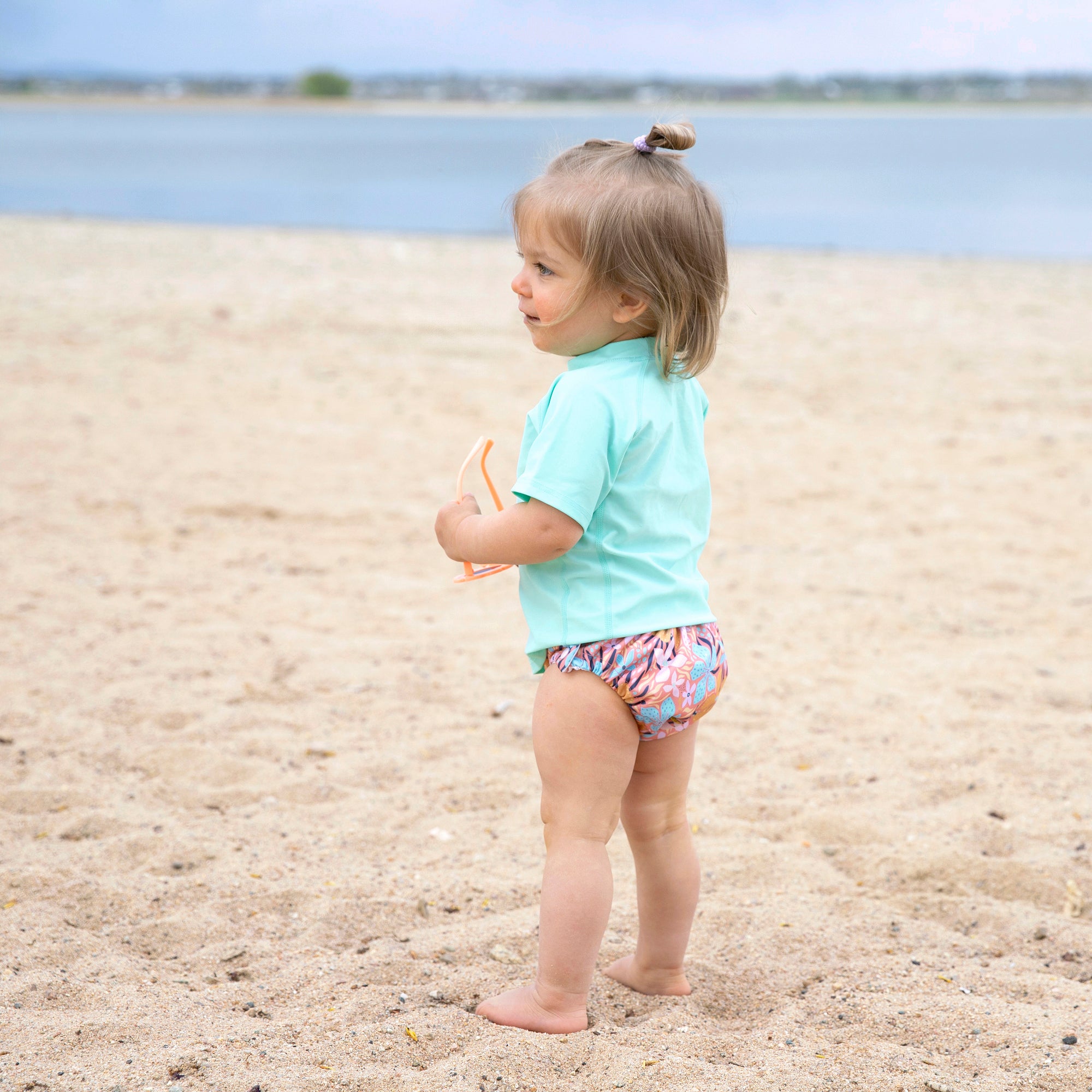
- Choosing the Right Size
- Fiber Facts
- Prep and Care
- Washing Your Trainers
Choosing the Right Size
Thirsties Cloth Trainers come in four sizes: Small, Medium, Large and Extra Large. Small trainers fit babies 20-27 lbs, medium trainers fit babies 26-35 lbs, large trainers fit babies 33-45 lbs and extra large trainers will fit babies 42-56+ lbs. You will notice that there is a small bit of overlap in the weight recommendations to accommodate those in between phases when growth spurts are common. The good news is that babies as small as 20 lbs and toddlers as large as 56 lbs and up will be able to use these trainers, meaning you can still use your cloth no matter what age you decide to potty learn.
Fiber Facts
The construction of this trainer really includes the best of so many worlds. Because potty learning is such a different journey for each kiddo, let’s look at how the each component of the Thirsties trainer adapts uniquely to the various stages of potty learning. The interior of this trainer is comprised of four layers of certified organic cotton. This will help catch potty accidents in the absorbent core, while still keeping a natural fiber against baby’s skin. Beyond the absorbent organic cotton, the wet zone has a layer of waterproof TPU laminate to prevent leaks and keep clothing dry. The gentle elastic at the legs prevent marks and discomfort, but make it easier to pull pants up and down. Here’s why this combination is my favorite:- Underwear-like design keeps toddlers positive about the potty learning experience and helps to encourage them to move away from diapers into trainers.
- Waterproof TPU layer, protecting car seats and clothing from leaks. Although the trainer is not a replacement for a diaper, this added layer will help protect against wetness and small accidents. Because no parent truly wants to clean a car seat.
- Natural fibers are always preferable as they are easier to clean, easier on baby’s skin and softer to the touch.
- Wide waist elastic prevents rolling and discomfort as well as provides extra protection from leaks and accidents.
- This fiber combination and construction allows for the perfect middle between cloth diapers and underwear. Thirsties Training Pants provide easy protection against accidents and the look of underwear, minus the bulk.
Prep and Care
Fun fact: Thirsties Trainers need to be prepped, just like cloth diapers. Because natural fibers contain oils that must be removed before use, you will want to prep your trainers very similarly to how you prep your diapers. Begin with new trainers and cloth diaper safe detergent. (Here’s a list of Thirsties laundry detergent favorites.) You’ll want to wash 1-3 times using a small amount of your cloth diaper safe detergent, drying in between cycles. You can choose to hang dry or dry on low in your dryer. Wool dryer balls will help you to speed up drying time in your dryer, if you choose to use that option. Make sure to prep any doublers or boosters that you plan to use with your trainers as well by following the same steps. Once your prep is complete, you are ready to use. (Well, your toddler might not be ready, but at least your prep is complete.) #ThirstiesTip If you are prepping a very small number of trainers and want to make good use of your water, feel free to bulk up your loads with some towels or other small items. This is normally when I run around the house to find all the loose reusable snack bags, random socks and other washables that my crew never seems to pickup. Think of it as a prep/deep clean/clean house win.
Begin with new trainers and cloth diaper safe detergent. (Here’s a list of Thirsties laundry detergent favorites.) You’ll want to wash 1-3 times using a small amount of your cloth diaper safe detergent, drying in between cycles. You can choose to hang dry or dry on low in your dryer. Wool dryer balls will help you to speed up drying time in your dryer, if you choose to use that option. Make sure to prep any doublers or boosters that you plan to use with your trainers as well by following the same steps. Once your prep is complete, you are ready to use. (Well, your toddler might not be ready, but at least your prep is complete.) #ThirstiesTip If you are prepping a very small number of trainers and want to make good use of your water, feel free to bulk up your loads with some towels or other small items. This is normally when I run around the house to find all the loose reusable snack bags, random socks and other washables that my crew never seems to pickup. Think of it as a prep/deep clean/clean house win.
Washing Your Trainers
Washing your trainers is very similar to washing your cloth diapers. Everyone’s water, washer and detergent will be slightly different, so you may need to adjust this routine to fit your lifestyle and your laundry. In general, you’ll want to use your cloth diaper safe detergent and follow these steps:- Prewash your trainers on warm with half the recommended amount of detergent.
- Wash your trainers on hot with the recommended amount of detergent.
- Add another rinse on warm.
- Hang dry or dry in the dryer on low. Turning your trainers inside out may speed dry times. If the trainers are stiff after line drying, you can throw them in the dryer on low heat with some wool dryer balls to soften them.
#Momrealness
So, what’s the good news? Toddlers who have previously used cloth diapers have a better chance at potty training more quickly than those who did not. Cloth diapers and trainers will help them to make the connection between feeling wet and the need to use the potty. Using cloth trainers will also help them to acclimate to underwear more smoothly, making the entire transition just a little easier.Here’s the great news: Never in my life have I been in the middle of a job interview, a college application or a date and had someone ask me when I was potty trained. Ever.Yes, it seems like this may be your entire life right now and yes, you probably think about whether or not another human has to pee far more frequently than just about anything else. Just keep in mind that, at some point, they will move on to the next phase and their high school diploma will absolutely not list how many accidents they had or the specific date they became accident free. I promise. Are you at the beginning of a new potty learning journey? If so, leave us a comment and tell us which feature of the new Thirsties Training Pant you love most. You can shop Thirsties Training Pants at your local retailer or online with Thirsties. For more potty training tips and tricks, you can visit Thirsties on Facebook or join the online community, Thirsties Groupies. Solidarity friend!



